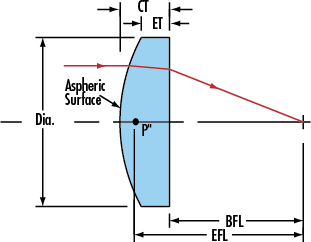
 TECHSPEC® 부품은 에드몬드 옵틱스가 설계, 사양 지정 및 제조하는 제품입니다. 더 알아보기
TECHSPEC® 부품은 에드몬드 옵틱스가 설계, 사양 지정 및 제조하는 제품입니다. 더 알아보기
TECHSPEC® Aspheric Lenses는 다이오드 레이저 출력의 포커싱을 포함하는 애플리케이션 등에서 광원으로 인한 구면 수차를 제거하여 포커싱하도록 설계되었습니다. 비구면 렌즈는 시스템의 수차를 최소화하고 렌즈의 개구수(NA)를 늘릴 수 있도록 합니다. 뿐만 아니라 다중 요소 시스템에 사용되는 광학 요소의 수를 감소시켜 시스템의 전반적인 중량 감소와 처리량 증가, 어셈블리의 간소화 같은 각종 이점을 제공합니다.
TECHSPEC® Aspheric Lenses는 집광 성능의 최적화를 위해 낮은 f/#를 특징으로 합니다. 또한 광학 시스템에 손쉽게 결합할 수 있도록 prescription data가 함께 제공되며, 고위 수차를 최소화하고 구면 수차를 제거할 수 있도록 컴퓨터를 이용한 최적화 처리 작업을 거칩니다. VIS 코팅 옵션은 425 – 675nm에서 반사율이 1.5% 미만이 되도록 하며, NIR 코팅 옵션은 600 – 1050nm에서 반사율이 1.5% 미만이 되도록 합니다. 대량 견적 및 맞춤형 비구면 렌즈 제작 문의는 당사로 연락 바랍니다.

에드몬드옵틱스는 특정 어플리케이션 요건을 충족할 수 있는 광학 및 이미징 부품에 대한 포괄적인 맞춤형 제조 서비스를 제공합니다. 에드몬드옵틱스는 프로토타입 개발, 본격적인 생산 준비 단계 등 단계와 관계없이 고객의 니즈를 충족하는 유연한 솔루션을 제공합니다. 에드몬드옵틱스의 엔지니어는 전 개발 과정을 지원합니다.
에드몬드옵틱스의 제조 역량:
자세한 내용은 에드몬드옵틱스의 맞춤형 제조 역량 페이지를 확인하거나 여기로 문의 바랍니다.
본사 및 지사별 연락처 확인하기
견적 요청 도구
재고 번호 입력 필요
Copyright 2023, 에드몬드옵틱스코리아 사업자 등록번호: 110-81-74657 | 대표이사: 앙텍하우 | 통신판매업 신고번호: 제 2022-서울마포-0965호, 서울특별시 마포구 월드컵북로 21, 7층 (서교동, 풍성빌딩)
The FUTURE Depends On Optics®